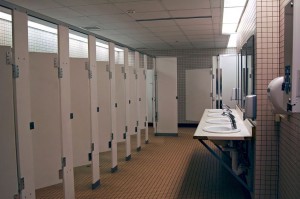Transgender People Just Need to Pee

Last week, the South Dakota Senate passed a bill that would require students to only use bathrooms and locker rooms that correspond to their assigned sex rather than their binary gender identity. If signed into law by Governor Dennis Daugaard, this would mean transgender boys could only use the girls’ restroom and locker room, and transgender girls could only use the boys’ restroom and locker room. Opponents of the bill say it would further discriminate against transgender youth who are already facing numerous social pressures and allows for more bullying to take place. Republican State Senator David Omdahl, however, says the bill is necessary to “preserve the innocence of our young people,” going even further with this comment on transgender youth: “I’m sorry if you’re so twisted you don’t know who you are. I’m telling you right now, it’s about protecting the kids, and I don’t even understand where our society is these days.”
It’s this last statement that shows how out of touch many Americans are with the realities of being transgender.
For starters, being transgender is not equivalent to “being confused.” The latest edition of the Diagnostic and Statistical Manual of Mental Disorders (DSM-V) recognizes gender dysphoria disorder in adults and adolescents as a real condition:
For a person to be diagnosed with gender dysphoria, there must be a marked difference between the individual’s expressed/experienced gender and the gender others would assign him or her, and it must continue for at least six months. In children, the desire to be of the other gender must be present and verbalized. This condition causes clinically significant distress or impairment in social, occupational, or other important areas of functioning.
The DSM-V also requires a diagnosis of gender dysphoria to ensure insurance companies cover medical transitioning: “The Sexual and Gender Identity Disorders Work Group was concerned that removing the condition as a psychiatric diagnosis—as some had suggested—would jeopardize access to care,” according to the DSM-V.
Most importantly, the South Dakota bill only perpetuates the myth that transgender women (those assigned male at birth who now identify as women) only want to use the women’s restroom to assault women. This is a myth often perpetuated by conservative Christians like Michelle Duggar who, in 2014, sent a robocall to voters in Fayetteville, Arizona, to vote no on a bill written to protect transgender rights, saying it would endanger young women by allowing men into “areas that are designated for females only.” This happened, of course, before the world learned that the Duggars’ oldest son, Josh, molested his sisters and his parents knew about it. Regardless of their hypocrisy, the facts are clear: transgender people are more likely to be assaulted in bathrooms by cisgender people than the other way around.
In 2013 Jody Herman of the Williams Institute surveyed ninety-three transgender people of various ages and ethnicities in Washington, DC, about their experiences with public gender-segregated restrooms. Of those surveyed, 18 percent reported being denied access to public restrooms (a quarter of this group were black). Sixty-eight percent reported being verbally harassed while trying to use a public restroom, told they were in the wrong bathroom, and threatened with violence. Even more concerning, 9 percent reported being physically assaulted in a public restroom, with actions ranging from physical removal to sexual assault. In the conclusion, Herman calls for government-level action: “Until public policy and public administration can meet the challenge to address this problem and rethink our reliance on gender segregation in our built environment, the onus will always be on the individual to try to navigate these spaces safely.”
The growing hysteria surrounding trans people using the restrooms of their choice led to the Twitter hashtag #WeJustNeedToPee. The movement began when trans woman Brae Carnes started taking selfies in men’s restrooms in response to conservative Canadian Senator Donald Plett’s proposal in 2014 to amend a transgender rights bill in order to maintain “sex-specific” public restrooms. His rationale was to stop pedophiles from taking advantage of the legislation that was in place. Several other trans people followed suit, posting bathroom selfies with the hashtag to bring awareness to the issue.
Progress has been made, though. In May 2014, then-governor of Maryland Martin O’Malley signed a bill that would allow transgender people to use the bathroom that corresponds to their gender identity. Although the law was met with resistance from a conservative group, the group’s petition to allow Marylanders to vote against the bill didn’t get enough signatures by its deadline.
And progress will hopefully convince Governor Daugaard to veto this South Dakota bill. A transgender high school student in the state, Thomas Lewis, has created a petition on the ACLU’s website asking Daugaard to do just that, stating that the bill “harms South Dakota’s children, wastes taxpayer dollars, and puts schools at risk of losing millions in federal funding.” As of this writing, the petition currently has almost 24,000 signatures, which is just 6,000 signatures short of its 30,000 signature goal. According to CBS News, the governor “initially responded positively to the [bill] but said last week he’d need to study it more before making a decision.”
